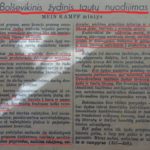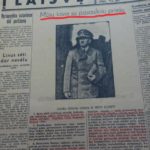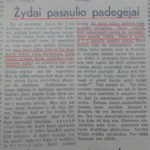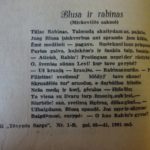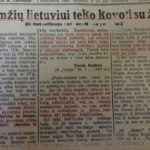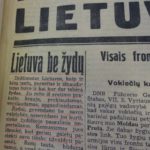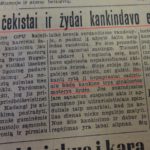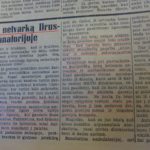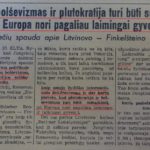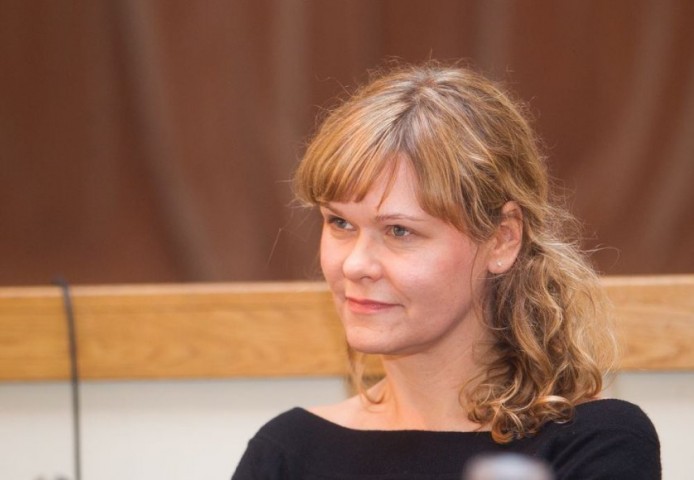
by Jūratė Juškaitė
manoteises.lt
Historians reckon about 17,000 people were deported from Lithuania during the first Soviet occupation. Cattle cars were sent deep into Russia from June 14 to June 18, 1941, and many of the deportees didn’t survive the first winter. Most people in Lithuania know these facts well, but June of 1941, often called the tragedy of the Lithuanian people, isn’t all that Lithuanian.
Research recently performed by cultural historian Violeta Davoliūtė soon to appear in the book “Population Displacement in Lithuania in the Twentieth Century” (Brill, 2016) attempts to bring the experiences of deported Lithuanian Jews back into collective memory regarding those days in June. The researcher says the narrative of deportations formed during the push for Lithuanian independence in the late 80s and early 90s contained ethnocentric elements and was often too “Catholicized.” Although the official politics of memory seem complicated if only for the widespread “Jewish Communist” stereotype, Davoliūtė says these and similar stereotypes have failed to divide this group of deportees, which is a tight-knit community based on shared experience.
In a recent discussion historian Dr. Arvydas Anušauskas was the first to call the 1941 deportations multiethnic. Why are they called this?
Because Lithuania was multiethnic, so the deportations were multiethnic. The composition of the 1941 deportations was different from the ones later after the second Soviet occupation when mainly residents of Lithuanian villages and the countryside were deported. The absolute majority of them were ethnic Lithuanians.
Lithuanians, Jews and Poles were deported in 1941. Of course the Soviets weren’t operating on ethnic criteria, they wanted to rid themselves of so-called socially dangerous elements, class enemies, and initially deported society’s elites. Jewish Lithuanian citizens constituted about 8.9 percent of repressed people in 1941 (about 3,000 people), and in the general Lithuanian population they accounted for 8.3 percent, so percentage-wise this is a very representative figure of society. Why is it important to underline that the deportations were multiethnic? Because when we discuss the memorial policies of the deportations, it is obvious the deportation narrative in Lithuania has been “Lithuanianized.” But this is not an exclusively Lithuanian experience; other groups living in Lithuania also experienced exile in 1941. It seems as if this is all known, but if today we asked not just students but also people working in higher education, it’s unlikely whether many would know that Jews also experienced deportation. I have no doubt that many would associate the historical experience of the Jews of Lithuania with the Holocaust exclusively, and that of ethnic Lithuanians with the deportations.
What do you think is responsible for the formation of this Lithuanianized narrative? It’s interesting that in discussions of the deportations Jews are considered Lithuanian citizens, they are not differentiated, they’re “Lithuanianized,” seemingly in order to show the trauma of the Lithuanian people in 1941. But then in discussions of the Holocaust, this tragedy is not considered the tragedy of Lithuanian citizens.
There are several reasons for this. First, we have to remember that the experience of exile was a very important factor for the political consolidation of society during the Sąjūdis [Lithuanian independence movement] period. It was then that the story of the afflicted and martyred nation was created, and this story was rather ethnocentric and egocentric. In the recently published book “Lietuvos žydai: istorinė studija” [Lithuanian Jews: A Historical Study], there are several pages devoted to the position of the Jewish community during the Sąjūdis period, quoting Dr. Irena Veisaitė, who considers herself both a Lithuanian and a Jew. The passage tells of her feelings at a Sąjūdis event where they spoke about the deportations as the greatest historical tragedy to have overtaken Lithuania, but didn’t utter a word about what had happened to Jewish Lithuanian citizens. Encountering this sort of ethnocentrism, Veisaitė wondered what she was doing at an event where her experiences weren’t considered important, but in a spirit of tolerance she decided that this was the first time Lithuanians were able to talk about their painful experiences, so she didn’t condemn that ethnocentrism. But this demonstrates well how Jews who survived exile, and on their return came face to face with the consequences of the Holocaust, might feel uncomfortable participating at these sorts of events.
Furthermore, the experience of exile was not just Lithuanianized, it was Catholicized as well, and deportation in Lithuania was usually commemorated with crosses, Catholic religious iconography, at Catholic Mass, and so on.
By the way, when testimonies were being collected from deportees, the majority of Lithuanian Jews who had survived deportation had already left Lithuania, and those who stayed mostly kept silent about it, and did not participate in the formation of the national story of deportations. One informant, for example, Olga E. from Anykščiai, who worked as a teacher in Naujoji Vilna after deportation, told about the first time she revealed to several colleagues she had been in Trofimovsk, only because the other teachers were discussing Lithuanian deportee Dalia Grinkevičiūtė’s memoirs. When they learned she had also been in Trofimovsk, they were astounded: she was a Jew, a Russian speaker named Olga. No one knew her real name was Golda, not Olga, or that she had learned Russian only in exile, and her native language was Yiddish, and her family had lived in Anykščiai for several generations.
Finally, that differentiation between “we” and “they” is connected with political competition for victim status. Unfortunately memory is often manipulated for political gain.
At this point we might remember the case of the Tuskulėnai Manor [in Vilnius]. It wasn’t just Lithuanians who were tortured there, there were also Jews murdered there, but the suffering and horror is commemorated there exclusively in Catholic symbolism.
Yes, so far there isn’t sufficient understanding that Jews were party to that suffering. This is almost completely unrepresented in our educational system and commemorative policies.
At the very least the official 1941 deportation commemorative policy seems complicated. To what extent does it represent the relations between the groups themselves at exile locations in Siberia?
I was surprised that the relations between Lithuanians and Jews in exile were just great; this is confirmed in many sources. Lithuanians and Jews in exile were a community of a shared experience. Many of the deportees in 1941 were educated, travelled people with rather liberal views. The regional factor was also very important: people from Lazdijai, Utena and Anykščiai placed stock in the idea they were “Žemaitijans.” Facts such as the many marriages between Lithuanians and Jews in exile also demonstrate close contact. For instance, this is what happened in the case of my informant Sara P. She met her future husband, deported along with his family, in the train car, during the brutal journey in the cattle car. Both sets of parents didn’t oppose the marriage which took place later. They survived deportation together and returned to Lithuania together, having undergone all the challenges. Because of their marriage, Sara refused to go to Israel, even after her husband’s death: she wants to be buried in Lithuania where her husband is buried. There are many such stories among the deportees of 1941.
Many have heard the story of deportee and dissident Dalia Grinkevičiūtė told in the school textbooks. But what many don’t know is that in exile she became friends with the Jewish girl Liuba Segal. The adolescent girls became good friends in exile. Grinkevičiūtė’s story has become the stuff of textbooks, Segal’s story is almost completely unknown in Lithuania.
This example shows that the story of Lithuanian Jewish deportees has actually not been told. Yes, there is a study or two, statistics, lists, but to make them real we need the faces of people, specific stories to help us better understand the diverse historical experience of our society. There are other unique stories from the 1941 deportations, for example, how people shared food from their houses before being deported, or symbolically celebrated Christmas together in exile. It’s also interesting that this emotional connection didn’t change even after returning to Lithuania and learning some of their former neighbors and Lithuanian acquaintances had contributed to the Holocaust. The connections made in exile between the majority of Lithuanians and Jews lasted a lifetime.
Coming back to 1940 and 1941, it seems again that we even then experienced a strange paradox: we have appropriated the first set of deportations and consider the deportees our own people, but Soviet collaborators had a clear ethnic identity. The ethnic origin of those Jews who supported the Soviet occupation and repressions is emphasized and underlined, and the image of the Jewish Bolshevik is especially strong in the Lithuanian press during the Nazi occupation.
During the Nazi occupation as genocide was being committed a very active propaganda campaign was prepared and, of course, anti-Semitism was an essential part of this campaign. The ethnic identity of the criminals and victims was always emphasized, for example, in the largest publications of that period in the Lithuanian language it was constantly repeated that Lithuanians were deported by no one else but Jews, i.e., that they are the true perpetrators of the deportations. The Jewish Bolshevik stereotype was actively cultivated as were conspiracy theories and racist myths. Many of these stereotypes had an enduring staying power, I would say until the present time, whereas during the Soviet period a different sort of propaganda was carried out, in which the Jewish genocide in general “never happened.” That’s why so much of it even today remains undeconstructed and misunderstood. For instance, many Lithuanian intellectuals were part of the Nazis’ genocidal propaganda campaign, but this has also been as it were “forgotten,”–their motivations, their forms of collaboration, their effect on society haven’t been analyzed sufficiently. There is no great enthusiasm to take up these topics, but it is well known the cultural aspects weren’t peripheral, they were a central part of the occupational policies of the Nazis. Although it’s often repeated that everything is supposedly known, everything has been researched already, this isn’t actually true. There is a real lack of information on how this collaboration took place and what effect the stereotypes spread by Lithuanians themselves then have on society today.
What effect might this position by some intellectuals have had on some Lithuanians who looked on passively as an incredible mass murder of unprecedented proportion took place very close to them, practically within view?
Clearly it is very difficult to measure what influence those publications and that position had. Even so, I think we might get some insights. The newspaper Naujoji Lietuva [New Lithuania] by editor Rapolas Mackonis, for example, is conserved at the Lithuanian Special Archive. In this private newspaper the editor always without any inhibition wrote “Jewish Bolsheviks” because he thought they were the same thing, indisputably. So most likely what was systematically and intentionally written and pounded into the heads of readers did have a significant influence over a significant portion of society.
I think it is still an undeconstructed myth that Jews allegedly deported and Lithuanians were deportees: some of the cultural workers who wrote anti-Semitic propaganda texts during the Nazi era left Lithuania after the war and became part of the [Western] exile community, others were repressed, others returned to Lithuania but remained apart from society. So it seems everyone found it comfortable to forget. But these sorts of historical experience aren’t forgotten so easily, and, as you see, memory returns. We might say that in Lithuania outside the confines of specialists in the field there is insufficient critical analysis of Nazi propaganda and its effect on society. Yes, perhaps experts have more or less determined how many were murdered and who did the murdering, but I think the wider cultural context of genocide–who spread myths and why, how they worked, what remains of it all today–hasn’t been studied yet. I am convinced that if this had been done, we wouldn’t see such facile usage of dehumanizing labels in public, because many more people would recognize this as a dangerous phenomenon and many would better understand its consequences.
Could you provide some specific examples?
An example, in Lithuania it’s a common thing during discussions to call an opponent “runkelis” [sugar beet, Lithuanian peasant] or “vatnik” [stereotype of patriotic Russian peasant], in other words, to use the rhetoric of dehumanization. This sort of speech is tolerated and even encouraged as simply more impassioned expression, cutting through the red-tape and so on. But if the rhetoric used in public discourse during the genocide committed during World War II were studied and understood, I have no doubt many more people would recognize it as aggressive and a potentially very dangerous activity which in certain circumstances could incite and contribute to the commission of violence.
Reading the memoirs of those who returned from exile to Lithuania, we see how alien their native land had become for them. The majority of Jews who returned left Lithuania. What motivated those who did not leave, who stayed?
The relationships of Jewish deportees who returned towards the land of their birth were complex. Their entire world–home, family, neighbors–had vanished. Many learned of the Holocaust complicity by people they knew personally and saw items from their homes in the homes of neighbors. This experience has been documented in testimonies by many Jewish deportees. My informant Liuba S. told how when she met former friends and classmates from the Utena Lithuanian gymnasium and other acquaintances she involuntarily always wondered whether they, too, had collaborated and perpetrated the Holocaust. So relationships with surrounding people and attitudes to one’s hometown changed deeply. Another informant, Aviva Z. from Virbalis, told how she and her family didn’t feel any alienation from others in exile, and they sang together of returning to their country, to their own people. But when her family came back they found it much more difficult to find their place here. All these people sooner or later left for Israel and their stories weren’t included in the narrative of deportations created during the independence period.
Those who stayed most frequently decided to do so for personal reasons, for example, because of mixed marriages. It should be noted here that Jewish deportees who returned to Lithuania didn’t live where they had grown up, where their homes had been before the war. And not because the Soviet government didn’t allow deportees to return to the places of their birth or because they placed various obstacles in the way of reintegrating with society. Most of them didn’t want to go back to places where the mass murder of their families had been carried out, it was too hard psychologically. So in returning to Lithuania they looked for relatives elsewhere, often settling next to other deportees who had returned. Emigration to Israel took place in a similar way. According to another informant, Polina (Perla) P., one day the people close to her–friends and neighbors including former deportees–simply decided to leave. She hadn’t made any serious plans about this, but together with her family joined the others with whom they were close.
The story of the family of Masha Gessen, a well-known critic of the Putin regime, illustrates the brutality of the 20th century: when the Soviets invaded Poland in 1940, her great-grandmother was deported to Siberia, which was responsible for her surviving [the Holocaust], whereas her husband Jakubas was jailed, and after the Nazis pushed the Soviets out of Białystok, he was sent to the ghetto, and died during the Holocaust. In the book where she tells her family history, Gessen doesn’t come to any firm conclusions on whether the deportation was pure salvation. How do exiled Lithuanian Jews who also survived only because they weren’t here understand this experience?
I would say in studies until 2011 the dominant opinion about the deportations of Jews was that deportation was rescue, since the chances for survival by deportees were so much greater. And of course that’s true. But this argument should be used in a nuanced manner, because far from all families of deportees would call this historical experience salvation. My informant from Rokiškis, Sana L., for example, four of her uncles were deported and three of them were murdered in the gulags. For a long time their niece even thought that only Jews were deported since so many of her family and people around her had been deported. The family of D. Einhorn with four children from Anykščiai was deported. One of them died en route and the family wasn’t allowed to bury their child, they were told in Russian “it will also be buried without you.” And while the Einhorn family lost all their relatives left behind in Anykščiai, they remember this moment as the most brutal, dehumanizing personal experience. The 1941 deportations from Lithuania were brutal and many died on the way to Siberia and after arriving there. For those who died, this was not salvation.
Full story in Lithuanian here.


